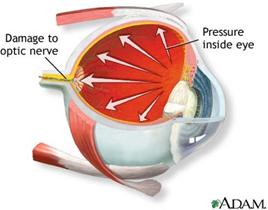 Glaucoma damages the optic nerve. The optic nerve is the part of the eye that carries the images we see to the brain. If your vision seems blurry, contains blank spots, or if you have eye pain or see rainbow-colored halos around lights, call your Eye M.D. right away.
Glaucoma damages the optic nerve. The optic nerve is the part of the eye that carries the images we see to the brain. If your vision seems blurry, contains blank spots, or if you have eye pain or see rainbow-colored halos around lights, call your Eye M.D. right away.
Glaucoma is a leading cause of blindness in the United States. Early treatment can often prevent loss of sight.
Symptoms & Diagnosis
The optic nerve is made up of many nerve fibers that carry images to the brain. It’s like an electric cable containing numerous wires. When glaucoma damages the optic nerve fibers, blind spots develop. If the entire nerve is destroyed, blindness results.
Primary open-angle glaucoma is the most common form of glaucoma in the United States. Typically, open-angle glaucoma has no symptoms in its early stages, and vision remains normal.
As the optic nerve becomes more damaged, blank spots begin to appear in your field of vision. You typically won’t notice these blank spots in your day-to-day activities until the optic nerve is significantly damaged and these spots become large. If all the optic nerve fibers die, blindness results.
Some people are born with the iris (the colored part of the eye) too close to the drainage angle. In these eyes, which are often small and farsighted, the iris can be sucked into the drainage angle and block it completely. Since the fluid cannot exit the eye, pressure inside the eye builds rapidly and causes an acute closed-angle attack.
Regular eye examinations by your Eye M.D. are the best way to detect glaucoma. There are five common tests for glaucoma: tonometry and ophthalmoscopy are considered more routine, but the visual field test, pachymetry and gonioscopy are also used in diagnosis.
Some of these tests may not be necessary for everyone. These tests may need to be repeated on a regular basis to keep track of any changes in your condition.
What are the risk factors for glaucoma?
- Age (65 years and older)
- Elevated eye pressure
- Family history of glaucoma
- African, Asian or Spanish ancestry
- Farsightedness or nearsightedness
- Past eye injuries
- Thinner central corneal thickness
- Pre-existing thinning of the optic nerve
- Not having eye examinations at the recommended intervals
- Steroid use
- Other health problems like diabetes, low blood pressure or migraine headaches
Your ophthalmologist, Eye M.D., will weigh all of these factors before deciding whether you need treatment. You may simply need to be monitored closely. This means your risk of developing glaucoma is higher than normal. Make sure to have regular examinations to detect the early signs of damage to the optic nerve.
Individuals with risk factors for glaucoma (e.g. family history of glaucoma or African or Hispanic/Latino descent) should have an eye examination every two to four years under 40 years of age, every one to three years between 40 and 54 years, every one to two years between age 55 and 64 years, and every six to 12 months for age 65 or older.
> Assess your risk for glaucoma
Regular medical eye exams can help prevent unnecessary vision loss. The American Academy of Ophthalmology now recommends that adults with no signs or risk factors for eye disease get a baseline eye disease screening at age 40—the time when early signs of disease and changes in vision may start to occur. Based on the results of the initial screening, an ophthalmologist will prescribe the necessary intervals for follow-up exams.
Last reviewed and updated in February 2009,
by the American Academy of Ophthalmology.

